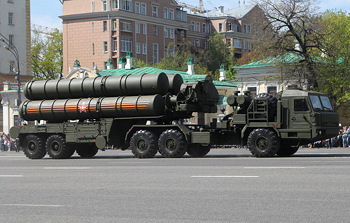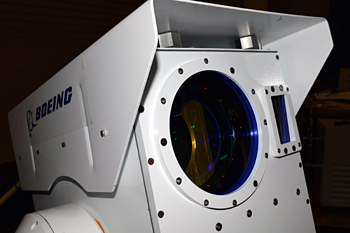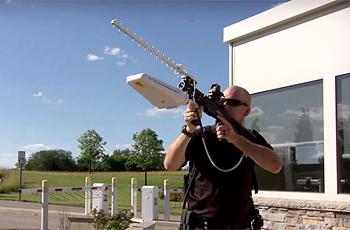INDIAN ARMED FORCES CHIEFS ON
OUR RELENTLESS AND FOCUSED PUBLISHING EFFORTS

SP Guide Publications puts forth a well compiled articulation of issues, pursuits and accomplishments of the Indian Army, over the years

I am confident that SP Guide Publications would continue to inform, inspire and influence.

My compliments to SP Guide Publications for informative and credible reportage on contemporary aerospace issues over the past six decades.
- Prime Minister witnesses 'Bharat Shakti' – a Tri-Services Firing and Manoeuvre Exercise in Pokhran, Rajasthan
- Interim Defence Budget 2024-25 — An Analysis
- Union Defence budget 2024
- Prime Minister Modi Commemorates Indian Navy Day in a Grand Ceremony
- Prime Minister Modi Flies in the LCA Tejas
- New Chapter in India-Italy Defence Ties
- Airpower beyond Boundaries
Downing Drones – big and small
 |
By Lt. General P.C. Katoch (Retd) Former Director General of Information Systems, Indian Army |



Photo Credit: Wikipedia, Boeing, Battelle
The rapid advance of drone technology has had alarm bells ringing across the globe. Drones represent not only stealth and means to no contact war carrying lethal warheads and ability of surveillance and electronic warfare capabilities but the added advent of small sized quadcopters and cybercopters have given the capability to terrorist organizations and loan attack wolfs to wreak monumental havoc into the unsuspecting targets. Naturally governments and militaries around the world are terrified by the prospect of drones carrying explosives or chemical weapons to places where they shouldn’t. It was therefore expected that countries would focus on developing technologies to counter drones. Going by media reports, India is planning to acquire the new generation Russian S-400 Triumf that can destroy incoming hostile aircraft, stealth fighters, missiles and drones at ranges of up to 400 kms. The deal will likely be finalized during PM Modi’s visit to Russia coming December. Incidentally, china has already contacted six S-400 batteries from Russia at a cost of $3 billion.
Russia has also stated that her new ‘microwave cannon’ can kill warheads and drones with ease at distances of six miles or 9.6 kms; equipped with a high-power relativistic generator and reflector antenna, management and control system, which when mounted on a special platform is capable of ensuring perimeter defense at 360 degrees. There are plenty theories about the best way to deal with the drone threat. Experiments are being done in jamming tachnologies to block communications from the operator to the drone, anti-drone rockets and guns. It may be recalled that in December 2011, Iran captured a top of the line American Lockheed Martin Sentinel stealth UAV (RQ-171) claiming it was brought down by her cyber-warfare unit, commandeering it in flight and safely landing it, albeit western sources claimed it was shot down. In August 2015, Boeing showed off its Compact Laser Weapon System that looks like a large camera that swivels around on a tripod (picture below). It is a much smaller, significantly more portable version of the High Energy Laser Mobile Demonstrator (HEL MD) demonstrated during 2014. This laser system burns a hole in the drone without any explosion or visible beam. Instead of a big truck mounted weapon system, it is a small system fitting into four suitcase-sized boxes and can be set up by two men in just a few minutes. Its laser, and, especially, the off-the-shelf gimbal (a fancy motor that can aim the laser and camera in any direction) it’s mounted on, make it precise enough to target different parts of a drone. Boeing has not disclosed the range but representatives said that if the drone can be seen through binoculars, then the Compact Laser Weapon System could hit it. Hitting the tail of the drone implies it will crash implying retrieving the mostly intact drone to retrieve data. On the other hand, if the drone is suspected to carry explosives, it can be completely destroyed as well. Depending on the target’s speed and distance, it can fire the laser within an inch or two of what it wants to hit. Because the laser moves at the speed of light, there is no need to lead the target. The speed of the gimbal is the primary limitation on the targeting front, the laser being precise. The laser is controlled with a standard Xbox 360 controller and a laptop with custom targeting software. Once in range, the system can take over from the human operator and control targeting and tracking automatically. Though current prototypes are meant to be used from static positions, the new weapon could be used on a moving vehicle or ship with minimal upgrades.
US firm Lockheed Martin recently unveiled its Counter-UAS system named ICARUS™ that can identify and intercept commercially available unmanned aerial systems. Law enforcement agencies in the US have gone in for the DroneDefender Rifle that uses radio pulses to disable a hostile drone within a 400-meter radius. These pulses interrupt the communications system of the drone, making it think it is out of range. The drone’s safety protocols then kick in, forcing it to hover, return to its point of origin, or descend slowly as it prepares to land. Because the weapon jams communication with the nearby operator, the DroneDefender also can prevent detonation and other remote functions. This tactical cyber rifle further provides a glimpse of the future of high-tech warfare.
The defender now has a wide array of options to engage, cripple and destroy drones big and small. India has been developing the ‘KALI’ (Kilo Ampere Linear Injector) linear electron accelerator for some time, which China thinks will eventually lead to a high-powered microwave weapon. DRDO is also developing ‘Aitya’, which is a vehicle mounted gas dynamic laser-based direct energy weapon system for hitting a missile in terminal phase at a distance of 5-7 km, as a prelude to create solid state lasers which are very portable and can be fitted on various platforms. We need to give focused attention to the issue with widespread availability of drones and intelligence agencies having given periodic warnings of the possibility of terrorists indulging in drone attacks.





